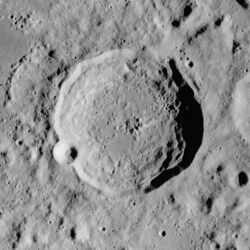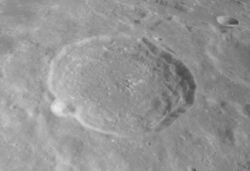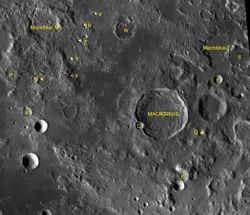Astronomy:Macrobius (crater)
 Apollo 17 mapping camera image | |
| Diameter | 63 km |
|---|---|
| Depth | 3.9 km |
| Colongitude | 314° at sunrise |
Macrobius is a prominent lunar impact crater located to the northwest of the Mare Crisium. Its diameter is 63 km. It was named after ancient Roman writer Macrobius.[1] It lies on the southeast edge of the Lacus Bonitatis, a small lunar mare. The somewhat smaller crater Tisserand lies just to the east.
The outer wall of Macrobius has a multiply terraced inner surface, with some slumping along the top of the rim. The small satellite crater Macrobius C lies across the western rim, but the wall is otherwise relatively free of significant wear. In the center of the floor is a central mountain complex. There is a low ridge in the western interior, but the remainder of the floor is relatively level.
Macrobius is a crater of Lower (Early) Imbrian age.[2]
Satellite craters
By convention these features are identified on lunar maps by placing the letter on the side of the crater midpoint that is closest to Macrobius.
| Macrobius | Latitude | Longitude | Diameter |
|---|---|---|---|
| C | 20.8° N | 45.0° E | 10 km |
| E | 18.7° N | 46.8° E | 10 km |
| F | 22.5° N | 48.5° E | 11 km |
| K | 21.5° N | 40.2° E | 12 km |
| M | 25.0° N | 41.0° E | 42 km |
| N | 22.8° N | 40.8° E | 5 km |
| P | 23.0° N | 39.5° E | 18 km |
| Q | 20.4° N | 47.6° E | 9 km |
| S | 23.3° N | 49.6° E | 26 km |
| T | 23.8° N | 48.6° E | 29 km |
| U | 25.0° N | 42.8° E | 6 km |
| V | 25.4° N | 43.3° E | 5 km |
| W | 24.8° N | 44.6° E | 26 km |
| X | 23.0° N | 42.2° E | 4 km |
| Y | 23.6° N | 42.2° E | 5 km |
| Z | 24.3° N | 42.6° E | 5 km |
The following craters have been renamed by the IAU.
- Macrobius A — See Carmichael.
- Macrobius B — See Hill.
- Macrobius D — See Fredholm.
- Macrobius L — See Esclangon.
References
thumb|right|Macrobius at center, near the terminator as viewed from Earth, with Mare Crisium to the right
- ↑ "Macrobius (crater)". Gazetteer of Planetary Nomenclature. USGS Astrogeology Research Program.
- ↑ The geologic history of the Moon. USGS Professional Paper 1348. By Don E. Wilhelms, John F. McCauley, and Newell J. Trask. U.S. Government Printing Office, Washington: 1987. Table 10.2.
- Andersson, L. E.; Whitaker, E. A. (1982). NASA Catalogue of Lunar Nomenclature. NASA RP-1097.
- Bussey, B.; Spudis, P. (2004). The Clementine Atlas of the Moon. New York: Cambridge University Press. ISBN 978-0-521-81528-4.
- Cocks, Elijah E.; Cocks, Josiah C. (1995). Who's Who on the Moon: A Biographical Dictionary of Lunar Nomenclature. Tudor Publishers. ISBN 978-0-936389-27-1. https://archive.org/details/isbn_9780936389271.
- McDowell, Jonathan (July 15, 2007). "Lunar Nomenclature". Jonathan's Space Report. http://host.planet4589.org/astro/lunar/.
- Menzel, D. H.; Minnaert, M.; Levin, B.; Dollfus, A.; Bell, B. (1971). "Report on Lunar Nomenclature by the Working Group of Commission 17 of the IAU". Space Science Reviews 12 (2): 136–186. doi:10.1007/BF00171763. Bibcode: 1971SSRv...12..136M.
- Moore, Patrick (2001). On the Moon. Sterling Publishing Co.. ISBN 978-0-304-35469-6. https://archive.org/details/patrickmooreonmo00patr.
- Price, Fred W. (1988). The Moon Observer's Handbook. Cambridge University Press. ISBN 978-0-521-33500-3.
- Rükl, Antonín (1990). Atlas of the Moon. Kalmbach Books. ISBN 978-0-913135-17-4.
- Webb, Rev. T. W. (1962). Celestial Objects for Common Telescopes (6th revised ed.). Dover. ISBN 978-0-486-20917-3. https://archive.org/details/celestialobjects00webb.
- Whitaker, Ewen A. (1999). Mapping and Naming the Moon. Cambridge University Press. ISBN 978-0-521-62248-6.
- Wlasuk, Peter T. (2000). Observing the Moon. Springer. ISBN 978-1-85233-193-1.
External links
 |



